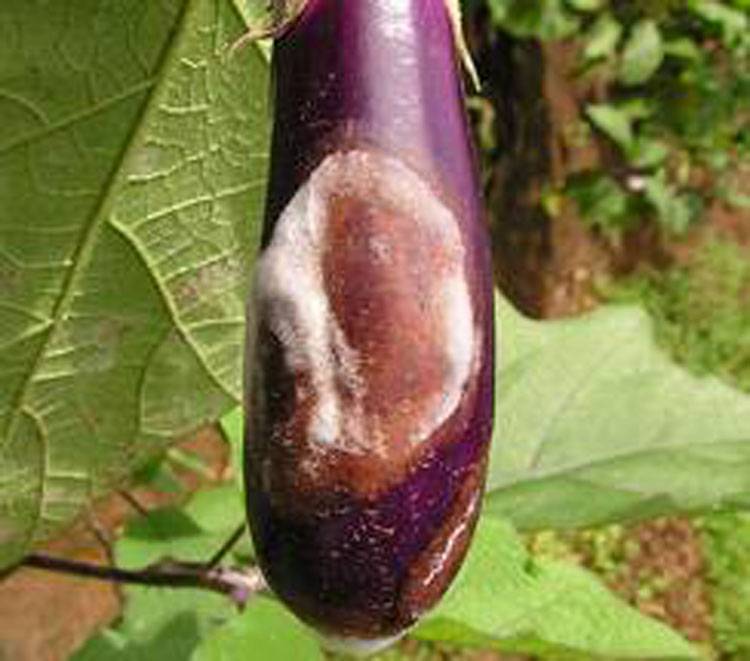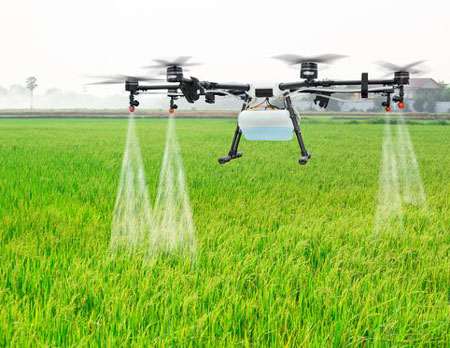Brinjal
Phomopsis Blight

Phomopsis vexans
Fungal Disease

Phomopsis vexans
Fungal Disease

Phomopsis vexans
Fungal Disease

Phomopsis vexans
Fungal Disease

Phomopsis vexans
Fungal Disease
Phomopsis vexans: A Devastating Pathogen of Eggplant
Introduction
Phomopsis vexans is a pycnidial anamorph with a teleomorph in the genus Diaporthe. It is a significant fungal pathogen affecting Solanum melongena (eggplant/brinjal/aubergine), its only major host. The disease caused by this fungus leads to substantial economic losses, reducing yield by over 50%. The pathogen is easily seedborne, producing large numbers of conidia that spread through wind, rain, and infected crop debris. Although it has a global presence, its distribution is limited in Europe and Africa despite suitable climatic conditions.
Key Characteristics of Phomopsis vexans
- Belongs to the genus Diaporthe.
- Produces pycnidia, which contain conidia responsible for infection.
- Easily transmitted through infected seeds, fruits, tools, and insects.
- Survives in crop debris, making it difficult to eradicate without proper field sanitation.
- Causes symptoms ranging from poor seed germination and damping-off in seedlings to fruit rot.
- Spread by wind, rain, and possibly insects.
Disease Symptoms
1. Seed and Seedling Stage
- Poor seed germination.
- Seedling blight leading to pre-emergence and post-emergence damping-off.
- Infection at the stem base, causing rotting and plant collapse.
2. Leaf Symptoms
- Small, circular, buff-to-olive spots in early stages.
- Lesions later turn cinnamon-buff with irregular blackish margins.
- Coalescing of lesions leads to large necrotic areas.
- Severe infection results in premature leaf drop.
- Blighted leaves covered with black pycnidia.
3. Stem and Branch Symptoms
- Blackish-brown, elongated lesions.
- Pycnidia develop within lesions, especially on young stems.
- Girdling of the stem leads to wilting and plant death.
- Smaller leaves and death of axillary buds.
4. Fruit Symptoms
- Initial symptoms appear as small, sunken greyish spots with a brown halo.
- Spots enlarge and coalesce, forming concentric yellow and brown rings.
- Large rotten areas develop, often covered with pycnidia.
- Infection through the calyx leads to mummification of the fruit.
- Fruit rot may continue in transit post-harvest.
- Younger fruits are more susceptible to infection than older ones.
Epidemiology and Disease Development
1. Mode of Transmission
- Seedborne transmission is the primary mode of spread.
- Conidia disseminated by wind, rain, and contaminated tools.
- Insects may play a role in spreading conidia.
- Infected seedlings act as a source of disease in nurseries.
2. Environmental Conditions Favoring Disease
- Optimal temperature for disease development is 25°C, with rapid progression between 20-30°C.
- Fruit rot develops fastest at 25°C and slows down at temperatures below 20°C and above 30°C.
- High humidity (above 90%) accelerates infection, leading to complete fruit rot within 7 days.
- At lower humidity levels (50%), disease progression is significantly slower.
Management Strategies
1. Cultural Control
- Use disease-free seeds to prevent initial infection.
- Destroy infected crop debris to eliminate overwintering inoculum.
- Practice crop rotation for several years to break the disease cycle.
- Maintain proper field sanitation by disinfecting tools and equipment.
2. Chemical Control
- Seed treatment with fungicides such as carbendazim or captan reduces initial infection.
- Foliar sprays of copper-based fungicides or systemic fungicides like azoxystrobin and mancozeb help manage leaf and fruit infections.
3. Biological Control
- Application of antagonistic fungi like Trichoderma spp. suppresses P. vexans.
- Use of neem-based extracts and biofungicides can provide additional protection.
4. Phytosanitary Measures
- Regulation of imported seeds and fruits to prevent the introduction of P. vexans into new regions.
- Growers should ensure that only clean, certified seeds are used.
Conclusion
Phomopsis vexans is a destructive pathogen of eggplant, causing significant yield losses. Effective management requires an integrated approach involving seed treatment, cultural practices, chemical applications, and biological control. Understanding its epidemiology and implementing preventive measures can significantly reduce its impact, ensuring better crop health and productivity.




